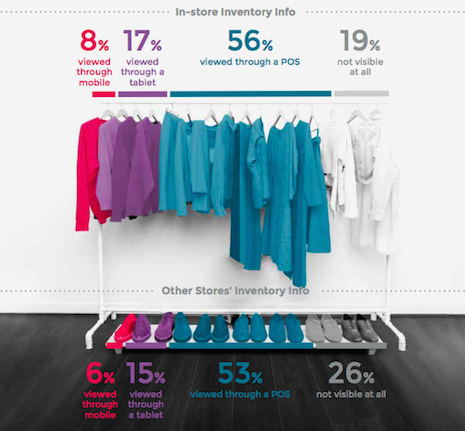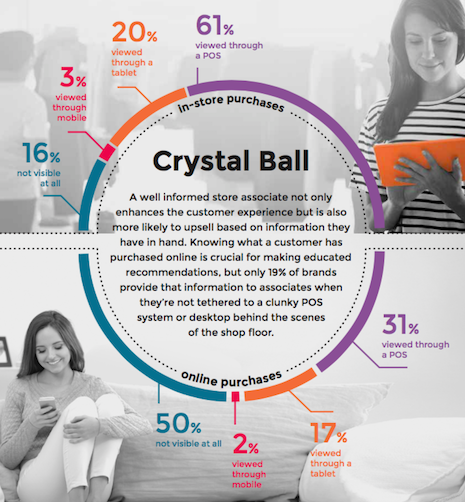 Burberry is one of the top performing luxury brands in the report. Image credit: NewStore
Burberry is one of the top performing luxury brands in the report. Image credit: NewStore
Physical retailers differentiate themselves from online counterparts through lower price points, a wider assortment of goods and unique experiences, but as ecommerce is priced to match and product selections expand, bricks-and-mortar sellers are defined only by experience.
Engaging with customers on the shop floor is one of the best ways of improving that experience and mobile technology can help sales associates accomplish that goal more effectively. But a report from NewStore found that only 51 percent of brands empower their associates with smartphones or other mobile devices to help customers.
"I think it is critical for store associates to use mobile devices in-store," said Stephan Schambach, founder and CEO of NewStore, Boston. "Customers are more equipped with product and brand knowledge when they enter a store today, and if they aren’t, they have their mobile device in hand ready and willing to help.
"It is surprising that only 51 percent of store associates carry a device themselves. Providing associates with the ability to answer inventory and product questions without leaving the customer’s side enhances their ability to act as a brand advocate and encourage sales.
"While 51 percent seems low, it’s progress. We found more than a 50 percent year-over-year, showing us that more brands are enjoying the benefits of utilizing mobile devices in-store."
Mobile tools
The idea of using mobile as a way of making sales associates in a store more effective on the shop floor has been floating around for as long as mobile has been a major force in consumers' lives.
But while countless brands have created mobile apps and tools for customers to use, fewer have embraced the idea of giving employees mobile power.
NewStore took a deep dive into some of the ways brands have used mobile in-store and came away with a middling impression. Brands are doing better than previous years, but they still are not doing enough.
For example, in addition to the aforementioned 51 percent of stores that give their sales associates mobile devices to use, only 46 percent of associates have the ability to access the brand’s online catalog through a device while on the shop floor.
Only 30 percent of brands currently offer the option of seeing in-store inventory from a mobile app or device and 31 percent of brands’ mobile Web sites have a “recently viewed” section to remind customers of what they were looking at previously.
 In-store inventory. Image credit: NewStore
NewStore’s report mentions brands such as Burberry and Sephora as standouts in the retail world, making smart use of mobile to expand the way customers interact with the physical store.
"Burberry was among the top scoring brands in two categories in our report - Mobile Experience and Path to Purchase & Fulfillment," Mr. Schambach said. "Its app’s ‘For You’ section features shoppable stories, with a simple “scroll up” function taking consumers to a product page and effortless online checkout with Apple Pay, for both its mobile web and mobile app.
"The concept of improving mobile experience is simple. Retailers with quick, easy to navigate mobile sites and native apps will be ahead of the curve in today’s digital environment.
"Many brand and retail sites and apps today are slow and glitchy. Consumers expect a quick and easy browsing and purchase experience, and simply will not tolerate anything less."
On the floor
While overall usage of mobile by luxury brands and retailers could stand to see some growth, a number of brands are already using mobile in unique new ways.
For example, department store chain Nordstrom is creating a link between digital browsing and the in-store shopping experience with the expansion of an omnichannel service.
Starting last fall, the retailer piloted a Reserve Online & Try In-store feature for six of its locations in its home state of Washington, allowing consumers to reserve items they see on its ecommerce platform in a dressing room at a nearby store. This service, which brings the convenience and speed of online shopping to the tactile bricks-and-mortar environment, is now being extended to about 40 stores across the United States (see story).
Additionally, brands in the hospitality industry have been working on integrating mobile into the booking process.
For global travelers, mobile is increasingly the digital tool of choice for planning and browsing purposes.
In-store inventory. Image credit: NewStore
NewStore’s report mentions brands such as Burberry and Sephora as standouts in the retail world, making smart use of mobile to expand the way customers interact with the physical store.
"Burberry was among the top scoring brands in two categories in our report - Mobile Experience and Path to Purchase & Fulfillment," Mr. Schambach said. "Its app’s ‘For You’ section features shoppable stories, with a simple “scroll up” function taking consumers to a product page and effortless online checkout with Apple Pay, for both its mobile web and mobile app.
"The concept of improving mobile experience is simple. Retailers with quick, easy to navigate mobile sites and native apps will be ahead of the curve in today’s digital environment.
"Many brand and retail sites and apps today are slow and glitchy. Consumers expect a quick and easy browsing and purchase experience, and simply will not tolerate anything less."
On the floor
While overall usage of mobile by luxury brands and retailers could stand to see some growth, a number of brands are already using mobile in unique new ways.
For example, department store chain Nordstrom is creating a link between digital browsing and the in-store shopping experience with the expansion of an omnichannel service.
Starting last fall, the retailer piloted a Reserve Online & Try In-store feature for six of its locations in its home state of Washington, allowing consumers to reserve items they see on its ecommerce platform in a dressing room at a nearby store. This service, which brings the convenience and speed of online shopping to the tactile bricks-and-mortar environment, is now being extended to about 40 stores across the United States (see story).
Additionally, brands in the hospitality industry have been working on integrating mobile into the booking process.
For global travelers, mobile is increasingly the digital tool of choice for planning and browsing purposes.
 The Crystal Ball. Image credit: NewStore
Fifty-two percent of travel related browsing is on mobile, and that number is only slated to increase. This data comes from an infographic released by AppLift, which lays out the details on how mobile has swept over the travel industry in the past few years (see story).
For the future, brands need to improve their use of mobile at every stage of the relationship with consumers.
"Our report found a decent improvement in the checkout experience on mobile, which is crucial for conversions," Mr. Schambach said. "The bottom line is that once a customer decides to buy something, it should be as easy as possible for them to get through the transaction.
"They shouldn’t be burdened with lengthy forms or slow load times," he said. "With increasing number of retailers accepting PayPal and Apple Pay through mobile, and with fewer fields being required before purchases, brands seem to be getting the hang of it.
"I’m hopeful for a future where the mobile experience in retail matches the expectations consumers have."
The Crystal Ball. Image credit: NewStore
Fifty-two percent of travel related browsing is on mobile, and that number is only slated to increase. This data comes from an infographic released by AppLift, which lays out the details on how mobile has swept over the travel industry in the past few years (see story).
For the future, brands need to improve their use of mobile at every stage of the relationship with consumers.
"Our report found a decent improvement in the checkout experience on mobile, which is crucial for conversions," Mr. Schambach said. "The bottom line is that once a customer decides to buy something, it should be as easy as possible for them to get through the transaction.
"They shouldn’t be burdened with lengthy forms or slow load times," he said. "With increasing number of retailers accepting PayPal and Apple Pay through mobile, and with fewer fields being required before purchases, brands seem to be getting the hang of it.
"I’m hopeful for a future where the mobile experience in retail matches the expectations consumers have."
